Part 1: A Radicalize the Hive Manifesto
For an abbreviated, animated version of this Manifesto, watch my TedX talk “What bees can teach us about social change” below.
The Manifesto section of Radicalize the Hive provides the reader with context about my perspective on beekeeping in the 21st Century. It examines where we are and how we got here by taking a look at the historical significance of honey bees in North America. This section is based on my own experience as a radical and queer beekeeper over the last decade.
Beneath ideas of “industriousness” and “productivity,” honey bees are translators of sweetness and light. They are facilitators of pollination – nature’s fluffers humming between stamens and pistols, full up with pleasure and drunk on sunshine.
Right now the honey bee/human relationship is transactional. We want to “save the bees.” If we want a reciprocal relationship with these creatures, we have to ask what we LEARN from the bees to begin to shape change so we can be more responsive to each other and our ecological allies.
To move back into a more relationship with the honey bee, we have to examine how entangled this sweet bee is with the historical relationship between and industrial agriculture. We have to acknowledge that relationship. We also have to look closer at the honey bees’ system of cooperation and ask what we can learn from honey bees as a “social super-organism.”
We can take lessons from inside the hive to begin the process of building new resilient worlds together, worlds that honor natural rhythms and lessons.
In this section I examine lessons from the hive:
- The root cause of the plight of the honey bee
- How honey bees effectively collaborate
- What humans can learn from honey bees to be more effective collaborators:
a. Review lessons that can help us shape change in OUR own exploitative industrial culture so we can be more responsive to each other and our ecological allies
i. Setting terms, sharing power, building collective understanding, working towards building consensus while being compassionate and forgiving ourselves
ii. Sharing purpose, AND sharing joy
- How we can apply this in our work to build networks of collective care and shared power. To me true collaboration is sharing power with each other rather than holding and manipulating power over one another, or over another species. This is how I have shaped my own iterative practice and my work, and in this section I share that with you.
The Story of this Book
The story of this book started in the spring of 2017 when, in the midst of a major life upheaval, I fled to Vermont to deepen my beekeeping practice with Kirk Webster. Inspired by my time at Kirk’s, I told a friend, “I’m going to write a zine about bees.” At the time, this “zine” was nothing more than a discombobulated collection of sketches and tools of the craft that I had gleaned from mentors and modified through my own experience.
After I spoke the words, I started thinking of the pollinator protection movements and where we are. I wondered who has the microphone in this movement? Who needs it? Who has access to bees and who doesn’t? I reflected on the story of how we got here and what momentum we need to move in a new direction.
The story of this book also started over a decade ago, when an uproar arose from within the national and international pollinator community about massive bee die-off. Pollinator die-off is a complex ecological issue that involves more than honey bees, and in fact, impacts native pollinators, butterflies and bats. But the 2.66 million honey bee colonies in the United States became the central actor in our collective conscious. Within the honey bee colonies, the issue was distilled down to “,” a “root cause” and no clear solution.
Over time, we’ve discovered the problem is complex — due to loss of a diverse habitat, the over-use of toxic pesticides, aggressive viruses and rapidly changing climate, honey bees as a species, are in danger.
This is a problem for honey bees, but also for humans because bees are a keystone species. Which means, we rely on them for our survival. Every 1 in 4 bites of food we take is thanks to honey bees. Imagine if bees ceased to exist. How would we pollinate foods like apples, avocados and almonds?
The parasites, viruses and pesticides that are impacting our honey bees, and our ecosystem are complex, and the challenges are constantly mounting as climate changes. Amidst these mounting challenges, a movement to “Save the Bees” has risen up in the collective conscious to help the important and charismatic — the honey bee. This rally call has built a movement of people engaged with the honey bee. Our relationship with this creature dates back over 8,000 years. Honey bees appear in ritual across the world from the Himalayas to Eastern Europe.[1]
Humans and honey bees are deeply intertwined, and because they are deeply entwined, we need to examine the use of the word “save.” According to the Merriam-Webster dictionary, the word “save” means to rescue or deliver from danger or harm and to preserve or guard from injury, destruction or loss.
What are we saving bees from? Our desire to save any single creature limits our vision and makes it hard for us to see the connections and relationships between ourselves and the creature we’re trying to “save.” The use of the word “save”puts us in a position of “savior.” Assuming the role of “savior” removes our actions and behaviors from the equation, giving us plausible deniability for why honey bees need saving in the first place. Authentic learning relationships can’t take place when we are trying to “save” those we seek to learn from. By claiming to be the hero, we are “othering” and creating a divide. Failing to honor the relationship between ourselves and the honey bee limits us to inadequate solutions to a larger systemic problem of environmental destruction and systemic oppression for capital gain. It defeats our capacity to see the whole story and respond in a way that speaks to our full humanity as living beings on this planet.
Our current economic model is based on endless growth, consumption and permanent race for profit. This economic system threatens the ecological balance of our planet and has multiplied inequities. As humans participating in this system, we stand on the precipice of ecological crisis. The idea that we will be the “saviors” is a grand self-delusion. A movement built on “saviorism” and the individualizing of a problem to one sub-group or species is one ignorant to the need for systemic change. If we can not imagine systemic change, we can not begin to abolish the systems that have perpetuated the oppression of people, land, water and animals since the United States became a country.
As Wendell Berry wrote in In Distrust of Movements:
“I must declare my dissatisfaction of movements to promote soil conservation or clean air or wilderness preservation or sustainable agriculture or community health or the welfare of children…I am dissatisfied with such efforts because they are too specialized, they are not comprehensive enough, they are not radical enough, they virtually predict their own failure by implying that we can remedy or control effects while leaving causes in their place. Ultimately, I think, they are insincere, they propose that the trouble is caused by other people, they would like to change policy but not behavior…To make ourselves into a practical wholeness with the land under our feet is maybe not altogether possible—how would we know?—but, as a goal, it at least carries beyond hubris, beyond the groundless assumption that we can sub-divide our present great failure into a thousand separate problems that can be fixed by a thousand task forces of academic and bureaucratic specialists. That program has been given more than a fair chance to prove itself, and we ought to know by now that it won’t work.”
Over the last 10 years, I’ve worked and learned through honey bees. I’ve come face to face with an ecological collapse brought on by the abuse and misuse of our planet fueled by an ever-expansive model of capitalism. The only way capitalism can be profitable is through a process of “primitive accumulation” — where things like slavery and colonialism are utilized to extract free labor and resources from people and planet. It’s not some innate quality of humans that has destroyed the planet, it’s a product of how the system of capitalism operates. If we aim to live in cooperative symbiosis with the planet, then we need to name the systems that cause planetary destruction. Labeling them helps us separate humans from the behemoth systems. Labeling helps us make room for humans generating potential solutions to the climate crisis that aren’t about exploiting nature but are about entering into a much more balanced relationship to the web of life. Honey bees are not the ones out of balance with the ecosystem, humans are.
The Earth and her fauna and flora have much to teach us. We need to remember that we are a part of a place, a history and a solar system of planets much bigger than ourselves. When I listen to the bees, I hear the stories of an organism ready to teach us lessons about successful cooperation AND the dangers of industrialized expansion.
In the year 2020, it is difficult to deny that each of us exists within the framework of systemic oppression that actively impacts our lives, our work and how we move through the world. With practice, we can actively examine how oppressive patterns show up in our minds and in our daily lives. It’s inside of us, and if we’re not actively doing the work to root it out and build awareness of it and deconstruct it through healing and equity building, we are not doing the work of radicalizing or abolishing the systems of oppression.
But we can! We can shape change if we remember Audre Lorde’s well-known declaration that “the master’s tools will never dismantle the master’s house.”
Two of the primary tools of human complacency in the face of climate disaster are despair and shame. Despair and shame are not effective tools for learning. They are tools of oppressive forces, like , , and . Despair and shame incapacitate our search for collective, systemic solutions — the only solutions that will truly work. By participating in shame and fear we are adhering to a dysfunctional culture instead of shaping our own. We need to practice building a new culture, while leaving room for our roles to be fluid. We need this practice so people can breathe enough to fight with passion and not from a disempowered space. So energetically we can ebb and flow like the hive, contract and expand and SWARM when the time is right.
I’m proposing in this moment we have an opportunity to plant our courage and our hope in the deep soil we’re standing in. We need to use our courage to address our collective needs by turning to our natural and elemental allies and ask:
“What can we learn?”
“What can we BE together? What can we DO together?”
So, what if instead of looking to modernity for solutions, we turn our attention towards the indigenous, ancestral and ecological ways of being in relationship with our surroundings? I think we stand to unlearn unsustainable patterns of expansion inherent in capitalism.
The honey bee and human relationship is old. There is evidence that humankind was gathering honey in the late Paleolithic times, ten to fifteen thousand years ago. An 8,000-year-old rock painting discovered at Arana Cave near Valencia, Spain, depicts a person climbing a ladder to gather honey from a hive on a cliff face. This picture was made when humans were still in the hunting and gathering as their primary source of sustenance, before they had begun to farm or domesticate animals.
Radicalize the Hive is the idea that we can start to work in reflective practice in ourselves, our communities and our organizations. We can use this charismatic microfauna as an example of the cooperative energy and momentum it takes to engage in change making work OR shift systems.
I’m going to say things that are critical of the beekeeping industry and draw attention to how many of us serve within and rely on that system for capital, resources and equipment. We’re going to look at the challenges and the reality that we’re all playing into the challenges and how we begin the work of radicalizing using the hive as a model.
While Colony Collapse Disorder was being labeled the culprit of a widespread honey bee collapse, I was in Dedham, Massachusetts in an itchy white suit with my French beekeeping mentor Jean-Claude holding a dolly with one hand and staring at an old whiskey barrel brimming full of bees. According to Jean-Claude, our instructions were to “remove it.” Jean Claude and I sealed up the entrance of the “whiskey hive”, packed the whiskey barrel into the back of my small pick-up strapped down with several carefully placed rachets and dropped it off at the at dusk. The next morning, again packed tightly into a bee suit, gloves and pull-up galoshes, I helped Jean-Claude carefully cut and band the hexagon shaped layers of brood and honeycomb and rubber band them into the wooden frames of a new bee hive.
Tens of thousands of honey bees hummed around us peacefully as we worked to rehome this wild hive. The scent of nectar was thick in the air. This was a moment of connection to land, air, water, plants and mycelium — all of these systems honey bees bind together. I was struck by how much honey bees have to teach us. Jean-Claude was studying wild hives and asking, “What are the bees doing to adapt?” and trying to mimic bee behaviors in his hive management strategies. From the very beginning of my beekeeping career, I was taught to look to honey bees for the answers.
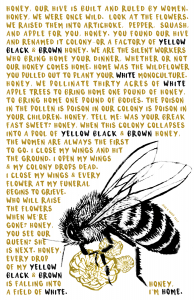
Industrialization of the Honey Bee
Before we discuss strategies for dismantling systems or become lost in the “magic of bees”, let’s look at the industrialization of the honey bee on the North American continent.
In the current agricultural system, with their pollination power, honey bees are responsible for pollinating 1 in 4 bites of our food in North America. Honey bees and the practice of keeping them or “beekeeping” is rooted deeply in the US agricultural system. And the United States (US) Agricultural system is rooted in racism, a social construct designed to exploit labor of black and African heritage people through slavery. Slavery launched modern capitalism and turned the US into one of the wealthiest countries in the world.
Honey bees aren’t endemic or indigenous to the North American continent. They were introduced to the US colonies in 1622 on board a ship that landed in Richmond, Virginia. Honey bees were and continue to be used to support agricultural expansion in North America.
According to CW Weber’s book, Sam or the History of Mystery[2], Indigenous peoples on Turtle Island quickly realized the advent of the honey bee was an indicator of coming colonizers. In 1820, the first honey bees made their appearance on the Braxos and Colorado rivers in Texas. Five years later, the Austin settlement began to rise on the banks of these two rivers, and Indigenous tribes were displaced from their land. White settlers stole indigenous land and displaced the Indigenous tribes in and around Austin, rendering them exiles on their native soil.
Throughout the growth and expansion of the so-called United States, honey bees were used to support monocropping agricultural models, and rapidly became a key player in the industrialization of agriculture.
Today honey bees are employed in migratory beekeeping practices, moved across the US via 18-wheeler (semi-trailer truck). Migratory beekeeping is an industry that begins with almond pollination in Southern California. Each year 1.7 million hive boxes full of bees are transported to California from all over the US via tractor trailer truck and set down in the 1.3 million acres of almonds.
This accounts for close to 85 percent of all the honey bee hives in the United States. California’s almond bloom is the largest pollination gig anywhere in the world. Those truckloads of bees don’t stay put in California’s Central Valley all year though. The almond bloom typically lasts just a few weeks in February. These bees and their keepers engage in an endless summer of chasing nectar producing plants. They crisscross the nation 10 months a year, working tirelessly to pollinate everything from oranges to blueberries. This industrial model of agriculture uses 388 million pounds of annually, a pesticide (and key ingredient in RoundUp) so toxic it is banned in the European Union, China and Brazil.
This work, as you can imagine, is taxing for both honey bees and beekeepers, because, just like capitalism, it relies on consistent expansion to be successful, leaving no room for , rest or recovery.
Approximately a decade ago, we began to see the impact of this agricultural system on our pollinators. Honey bee hives began “failing” or dying out completely by the thousands. And so, like canaries in the coal mine, honey bees are giving us a warning about the impact of these expansive systems on our environment.
Today we know the biggest parasite honey bees face is the . In 2018, Sam Ramsey of the University of Maryland discovered that varroa mites feed on the lymphatic system of the honey bee — resulting in a weakened immune system and the rapid spread of viruses and diseases within the hive. We now know that these viral loads are combined with a loss of pollen and nectar based forage. Loss of forage is due to climate change. Systemic use of pesticides and herbicides used to maintain our food system poses a major threat to the immune system of the honey bee, making honey bees more susceptible to bacterial and viral infections manifesting in the hive.
Last year, according to a national survey by the Bee Informed Partnership, 40 percent of managed hives in the United States were lost to viruses and Varroa mites. This is an alarming rate of loss. These losses were experienced throughout the season. What does that mean? It means hives were lost not only during the long cold winter months, but also during the active honey bee keeping season across the continental United States.
From this industrialized model of beekeeping we can see that mimicking systems of expansion and exploitation is not a generative way to build new worlds. So where do we find hope and change amidst this catastrophic environmental crisis?
Honey bees have taught me that hope and change can begin very small.
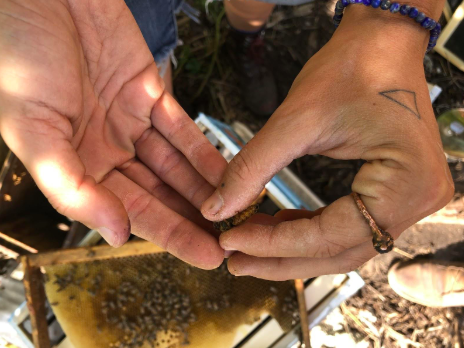
This is a queen bee (see image above). A queen bee is no bigger than the thumbnail on my right hand, but she can lay over 2,000 eggs a day. Each and every one of those eggs is a hope of a future generation, laid with the hope that flowers will bloom, and nectar will flow and each bee will have enough food to grow into an adult honey bee.
For more on this, see video link below.
Strategies
Activist and facilitator adrienne maree brown says “Small is all.” Leopold Kohr coined the term “Small is beautiful.” And when it comes to honey bees I have to agree.
are already working with the honey bees’ natural systems of adaptation to find ways to support bees and radicalize the beekeeping industry. It takes incredible commitment and careful work to build change at this small scale, especially when you’re facing down behemoths like “industrial agriculture.” But beekeepers are hoping to build a new culture of beekeeping by working with the adaptive capacity of honey bees that they observe in the wild.

“You have to act as if it were possible to radically transform the world. And you have to do it all the time.” – Angela Davis
Beekeepers like Melanie Kirby of Zia Queen Bees of New Mexico are raising adaptive bees that can deal with disease and rapidly changing climate. Melanie refers to her work as “seed saving, with bees.” These “seed queens” are adapted to the bioregion where they were raised, making them more resilient than bees imported from outside the region.
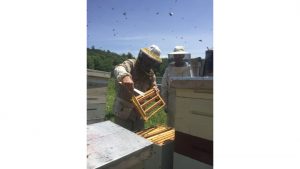
Kirk Webster, a beekeeper in the hills of Vermont raises honey bees using no chemicals or treatments in his hives. Kirk’s bees can survive long harsh winters while successfully resisting diseases.
As a small-scale beekeeper myself, I’m looking into ways to build resilient community while fostering a connection between humans and honey bees. Last fall, my friends and I hosted the first Queer and Trans (QT) bee field day at my farm in Western Massachusetts. Together, we gathered 18 new, or aspiring queer and trans beekeepers to foster an affirming space to share skills and resources. We gathered to build a deeper relationship with honey bees and practice interdependence with one another.
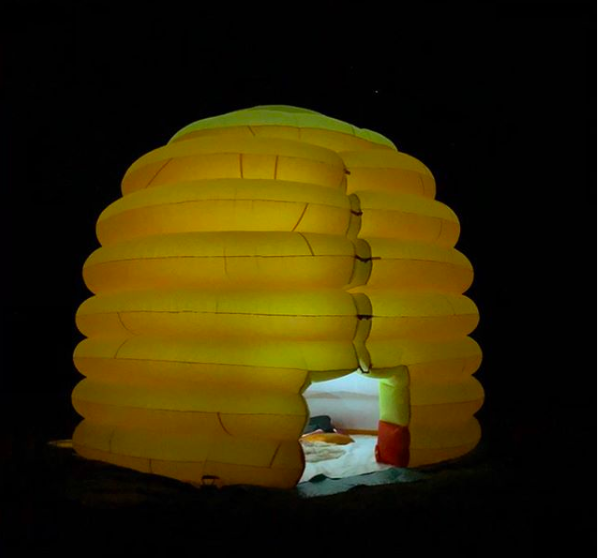
At the inaugural bee day we opened up bee hives, and learned about what happens inside. On plant walks we learned about plants bees pollinate in the ecosystem. Facilitators told stories of how both humans AND honey bees can use each plant. We used hand crafted guidebooks to identify plants, made by our rad planning team of QT organizers from across a wide spectrum of identities, sharing a collective purpose. Through QT Bee Day events, we’re making bees a gateway bug for shaping new relationships with the natural world by queering our understanding of bees. What does that mean? It means we’re reclaiming a forgotten relationship with the natural world that moves beyond binaries. We are shaping relationships with the natural world built on reciprocity.
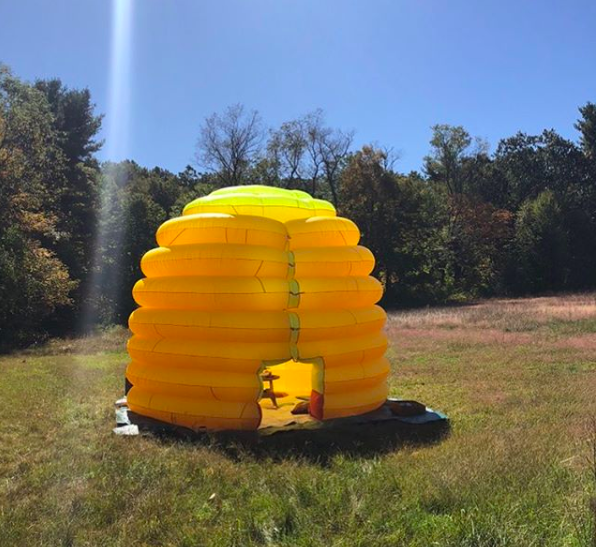
Small actions like these are building a culture of “small-scale” beekeeping. These practices collectively reframe the value of honey bees — rather than using bees as a tool for pollinating industrial agriculture, we’re using bees as a model for building community.
At my farm, we are supporting aspiring beekeepers and teaching skills like swarm catching and how to raise queens. Through actions like these, small-scale beekeepers are building new beekeeping communities that are collaborative, while supporting thriving hives.
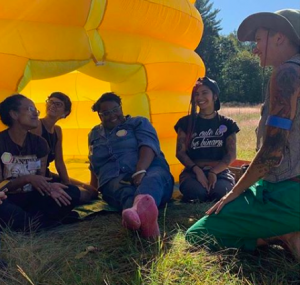
When my collaborators and I facilitate small groups of aspiring beekeepers, we reflect on our visible and invisible social identities including race, ethnicity, class, gender, sexuality and ability. We name where people hold power and privilege because you can’t share power if you don’t know you have it. Diverse perspectives and identities are important, but they can only become powerful when we make space for them to be heard, valued and integral to the collective. Because we’re not bees, we have to make space for humanity which means making space for our differences AND our traumas. We have to make room for healing and repair. The decision-making we engage in within our communities has to be accessible for those marginalized by our current system. It has to call in our survivors and create space for compassionate listening and the bravery to share diverse perspectives and experiences as a group.
When we build high trust groups like this, we can be very coherent and effective. Bees trust innately, it is part of their biology. But we have to build it, just like we build new neural pathways in our brain when we learn new habits. Then we can be agile and adaptive in a complex and rapidly changing environment, while sharing power.
Lessons from the Hive
You don’t have to be a beekeeper to start sharing power. You can address big issues by starting with small actions to combat environmental injustice in the small groups you’re a part of today. The lessons we can learn from the hive are lessons on iterative process. Iteration is the repetition of a process. In a healthy hive, we see some basic essential functions and lessons we can adapt to our own groups from each.
Essential Function:
In a balanced ecosystem, honey bees are facilitators of pollination — transforming sunlight into sweetness by nectar and pollen into resources for their young. They are facilitators of interspecies sex humming between stamens and pistils. When hives are gathering these important resources from nectar producing plants, they are full up with pleasure and drunk on sunshine. They are in a reciprocal relationship with the ecosystem in which they are pollinating. They draw resources from and contribute to the plants’ capacity to thrive. Honey bees pollinate food they’ll never eat, store nectar and pollen for young they’ll never meet and swarm to locations they decide upon while suspended in midair.
LESSON:
Relationship with our surroundings can be joyful, purpose-filled and interdependent.
Internally, when we look into a hive, we see individuals working in roles, practiced with ritualistic precision by each bee, for the collective benefit of the hive’s longevity. Every hive is made up of 30,000+ worker bees, one queen and several drone bees.
Essential Function:
Worker bees are the force of collaboration in a honey bee hive. They play a very important role in the hive. Workers begin as cleaner and nurse bees who prepare wax cells for their sisters’ birth by cleaning, polishing and adding food to each cell. They care for the young bees of the hive. Young bees also spend time as builders. They engage in an act called festooning, in which they hang off of one another secreting wax from scales on their bellies and passing it arm to arm to mouth and chewing it into hexagons in which to store young, food and water. Foragers gather resources for the hive. They can travel 5-8 miles to collect pollen, nectar, propolis and water that will feed and hydrate the hive.
LESSON:
We can play many roles and move between them fluidly.
Essential Function:
Wax is the foundation of a healthy hive. It is the architecture upon which the entire hive is built, the central nervous system of the hive. Hexagons hold the most weight with the least amount of material.
LESSON:
Work together to build solid foundations on which to collaborate.
Essential Function:
Pollen and nectar are collected from flowers by forager bees. These resources are transmuted into food, called bee bread, for the current young, and stored as resources for the next generation in the form of honey.
LESSON:
Share in the abundance, store it for moments of contraction.
Essential Function:
Propolis is collected by forager bees as resins collected from evergreen trees. Propolis is mixed with enzymes in a honey bee gut — it seals the inside of the hive, making it a sterile space for the young, and seals the hive from moisture, cold and predatory insects.
LESSON:
Cultivate a space that is healthy for everyone to thrive.
One of the most crucial elements of a healthy hive is clear, consistent and collaborative communication.
Honey bees communicate through several methods:
- Pheromones – a form of scent-based communication through glands on the honey bees’ head and butt
- Vibration
- Dance
- Consensus building
We can look to the hives to see a clear mechanism for communication and consensus building. Honey bees reproduce by swarming. During a , honey bee communication is collaborative and embodied. Honey bees make cooperative decisions through listening and responsiveness.
The most profound example is a swarm of bees.
During a swarm, honey bees collectively embrace change.
Swarms happen in Spring — when the bees have collected an abundance of nectar and pollen and the hive is FULL of workers. The bees begin to outgrow their space and prepare to split 1 hive into 2.
The bees will begin to raise a new queen by feeding tiny larva a special diet of royal jelly and pollen. The queen, much like a butterfly, spins a small cocoon inside beeswax and begins to pupate — or grow into an adult. When the new queen emerges from her cocoon, half of the bees in a hive will leave the hive with the old queen. They leave behind a newly hatched queen, young bees and plenty of food.
During a swarm, the bees cluster around the queen and hang from a branch. The swarm of bees then begin their search for a new home.
This past summer while conducting field work with a collaborator, I was stopped dead in my tracks by a swarm in action. We watched as tens of thousands of bees flew out of a hive collectively and hovered in a cloud all around us. They quickly clustered on the limb of a nearby maple tree, and we watched as “scout bees” began to search out new places to call home. It’s a fascinating process. Scout bees begin seeking out a dry hollow space. Then, they return to their sisters and begin to dance out the details of these locations. One by one their sister bees travel to these proposed locations and check them out. When they each return, they vote on the best location by taking up the dance of the scout bee who chose the best spot. The decision about where to go is an important one. They have no resources with them except what they carry in their stomachs, and they need to find a safe, dry place to build their new home. Communication about new sites is vital to finding the best location. The dancing deliberation continues until the bees reach consensus about the best place for their new home. Finally, they leave their outpost and head for their new home.
To entice our swarm, my friend and I bungee strapped an old hive box about 10 feet up in an old chestnut tree to see if they’d like it, and they did! The next day the honey bees had chosen this box to build their new home within and were already building a foundation of wax to rear their young upon.
If we look to the swarm, we can see a road map for collaboration through consensus building. In the process, every bee retains their autonomy in this consensus building. There is no charismatic leader. The queen is a passive onlooker in the worker bee’s collective process. Consensus building amongst honey bees is an intricate democracy. The consensus is built by sharing power, information and trust.
According to honey bee researcher Tom Seeley, “These bees achieve their collective wisdom by organizing themselves in such a way that even though each individual has limited information and knowledge, the group as a whole makes first-rate collective decision.”
But we are not bees; we are not yet as agile as they are in a group. Plus some of us think we can’t even dance! There is deep complexity to our humanity, and our shared vs. autonomous experiences. There needs to be room for our autonomy along with opportunities for collective process. So how do we build successful collaboration in our lives? Even if you have two left feet, you can begin the “dance” of learning how to collaborate.
Bees take time to build communication that is iterative, equitable, interdependent and accountable. They eliminate charismatic leaders and to mimic this concept we have to minimize hierarchy.
We have to practice consciously sharing power so we can begin to have honest dialogue while holding ourselves accountable to our purpose. Just like our team of QT bee day organizers, we can begin to practice sharing trust. With practice, our human groups can become agile like honey bees. We can build intimacy in our collaboration that truly takes everyone into consideration and makes room for new ideas. Authentic human consensus building can help us recognize we’re part of a larger whole.
We, as humans, with autonomy, can move from this model of “collectivism” and towards accountability. We can build intimacy in our collaboration that is accountable so that when we need to be accountable to each other we can be. When we need to address harm, we can, so we can discover if/how to move through it. That requires holding space for grief, trauma, apology and reparations. I think accountable communication in groups, organizations and communities happens when we start small and build clear mechanisms for communication and accountability. Then we can aim to be accessible and build trust across differences, but this can only happen with radical honesty and iterative practice in high trust groups.
A high trust group can be very coherent and effective after establishing agreement about state, direction and norms. If you want to be agile and adaptive in a complex and rapidly changing environment, you must move as much decision-making power as possible into a consensus model that is small enough to be governed by authentic dialogue.
In small groups we can assess and respond to the pressures outside our group effectively and quickly address dysfunction and respond accordingly. In small groups we can abort a project if conditions are unhealthy or not generative. We can know when to fold. We can know when to set and hold boundaries for the health of our community. In small groups we can build efficient systems, we can grow with each individual, clear about the roles they need to play for cooperative success. This creates space for us to focus on thriving when conditions are optimal and sustaining them when under pressure.
Then decision making can become iterative. There is trust built when we aim for accountable and nonhierarchical systems, and this trust helps us build our capacity to be interdependent.
Honey bees teach us to:
- Build solid but malleable foundations
- Embrace Change
- Make Equitable Decisions through Consensus
Bees are a whole world, and they open you up to these other worlds — blossoming trees, spiders, ants, predators, opossums and bears, and how all of these things interact with each other. If we look to the ecological world all around us, to our allies in the plant, animal and insect world, we can draw inspiration for how to shape change. We can build our muscles for understanding natural rhythms and lessons once again. We can take lessons from inside the hive to begin the process of building new resilient worlds together beyond the hive. We can build collective care through shared networks. Networks that build power with each other. To me, this is true collaboration, power with each other rather than power over one another, or over another species.
When you can see systemically, in patterns, in iterations, in , you realize how flawed our social systems and structures are because they are both limited AND disconnected. The more you realize that, the easier it becomes to decouple from degenerative practice and align ourselves with ecologically responsive, adaptive and generative process.
When we need hope, we can look at the small-scale changes already underway. Small-scale beekeepers are already building collaborative relationship with honey bees, raising bees who are adaptive and resilient. Small is where we begin to build trust with one another. We can take trust building and change making in steps, in movements, in seasons. We can practice together. We allow for mistakes and shift behavior, thought and action. We can dismantle, rebuild and rewire. We can create new pathways to change. And take back our humanity, our intimacy and our shared understanding.
For an example of how to implement collaborative practices into your work, visit this resource.
For an instructional guide to using these principles in your community, visit this recorded webinar here.
_
1See research by Eva Crane on the world history of beekeeping
2“Sam or the History of Mystery”
Media Attributions
- Honey bees © Jess X. Snow is licensed under a CC BY-NC-ND (Attribution NonCommercial NoDerivatives) license
- Holding a queen bee © Ang Roell is licensed under a CC BY-NC (Attribution NonCommercial) license
- Close-up of beekeeper hands © Ang Roell is licensed under a CC BY-NC (Attribution NonCommercial) license
- In the field with honey bees © Ang Roell is licensed under a CC BY-NC (Attribution NonCommercial) license
- Inflatable skep beehive model at night © Ang Roell is licensed under a CC BY-NC (Attribution NonCommercial) license
- Inflatable skep model during the day © Ang Roell is licensed under a CC BY-NC (Attribution NonCommercial) license
- Queer & Trans Bee Day © Ang Roell is licensed under a CC BY-NC (Attribution NonCommercial) license
involving interaction between two different organisms living in close physical association; denoting a mutually beneficial relationship between different people or groups
the action or process of settling among and establishing control over the indigenous people of an area
an abnormal phenomenon that occurs when the majority of worker bees in a colony disappear, leaving behind a queen, plenty of food, and a few nurse bees to care for the remaining immature bees. While such disappearances have occurred sporadically throughout the history of apiculture, and have been known by various names (including disappearing disease, spring dwindle, May disease, autumn collapse, and fall dwindle disease), the syndrome was renamed colony collapse disorder in late 2006 in conjunction with a drastic rise in reports of disappearances of western honey bee (Apis mellifera) colonies in North America. Beekeepers in most European countries have observed a similar phenomenon since 1998, especially in Southern and Western Europe; the Northern Ireland Assembly received reports of a decline greater than 50%. The phenomenon became more global when it affected some Asian and African countries as well.
Small fauna or animals IE insects, microscopic animals.
a social system in which men hold primary power and predominate in roles of political leadership, moral authority, social privilege and control of property. Some patriarchal societies are also patrilineal, meaning that property and title are inherited by the male lineage.
The belief that white people are superior to those of all other races, especially the black race, and should therefore dominate society. In the United States, white supremacy is reinforced by systemic, cultural and institutional norms, and this is referred to as “white supremacy culture”.
Settler colonialism is a form of colonialism which seeks to replace the original population of the colonized territory with a new society of settlers. As with all forms of colonialism, it is based on exogenous domination, typically organized or supported by an imperial authority. Settler colonialism is enacted by a variety of means ranging from violent depopulation of the previous inhabitants, to more subtle, legal means such as assimilation or recognition of indigenous identity within a colonial framework.
a place where bees are kept; a collection of beehives; a yard where bees are kept; otherwise known as a "bee yard"
a broad-spectrum systemic herbicide and crop desiccant. It is used to kill weeds, especially annual broadleaf weeds and grasses that compete with crops.
A hive contracts, or stops laying eggs and drawing wax, when the nectar flow stops, and the bio region is in a dearth of nectar. Contraction in a hive can also happen in response to pending winter.
Varroa destructor (Varroa mite) is an external parasitic mite that attack and feeds on the honey bees Apis cerana and Apis mellifera. The disease caused by the mites is called varroosis. The Varroa mite can only reproduce in a honey bee colony.
A practice of reclaiming beekeeping as a practice that supports honey bees, rather than uses them as a tool in pollination. Beekeepers are reclaiming the “means of production” by raising bees who can survive in their bio-regions, sharing honey bees with their community and rescuing and relocating wild hives through live bee removal services.
The survivor stock is comprised of bees that successfully overwintered in the presence of Varroa mites with no chemical treatments. If the offspring of these bees is also able to survive in the presence of mites, breeders will be on their way to producing a Varroa-resistant strain. Survivor stock are bred for the genetic trait “longevity”.
Change in form, nature, or substance
Swarming is a honey bee colony’s natural means of reproduction. In the process of swarming, a single colony splits into two or more distinct colonies.
A fractal is a shape made of parts similar to the whole in some way; Fractals are not limited to geometric patterns, but can also describe processes in time


Feedback/Errata